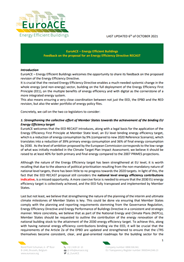
Press Release – Agreement sends important signal on role of energy efficiency
After a 16-hour long round of negotiations, the European Parliament and the Council reached an agreement on the Energy Efficiency Directive (EED). While EuroACE had hoped for more ambition, the final agreement represents an improvement over the 2018 version. Critical now is the implementation at national level and EuroACE and its members call on Member States to take the new objectives into account in their revised National Energy and Climate Plans. The upcoming vote on the Energy Performance of Buildings Directive (EPBD) also needs to follow suit.
Joint Letter – A binding 14.5% energy efficiency target in 2030 for reviving Europe’s economy
Business leaders urge the EU co-legislators to substantially raise the ambition in the Energy Efficiency Directive (EED) recast and to set a 14.5% target for energy efficiency in 2030, with binding targets both for primary and final energy consumption and binding national contributions. This is all the more pressing in a time of unprecedentedly high energy prices and a devastating climate change.
Buildings in the Fit for 55 Package for a Climate Neutral Economy in 2050
To achieve at least 55% reduction in GHG emissions by 2030, the EU must reduce GHG emissions from buildings by 60%, their energy consumption by 14%. In view of these targets, and in the context of the Fit for 55 Package, we must ensure that across different Directives affecting buildings and their energy performance, we create a coherent and robust framework that will lead us to a zero-emissions building stock by 2050.
EED (2021)
As part of the ‘Fit for 55’ Initiative, which is a legislative package that aims at overhauling the EU’s climate policy architecture to put the EU on track to deliver on its 2030 climate target of 55%, the EED is being revised.
EuroACE welcomes the revision of the EED and proposes the following recommendations:
1. Mainstream the EE1 Principle: from policy design towards a more upskilled workforce
2. EU and National Energy Efficiency Targets should be ambitious and mandatory
3. Reinforce the exemplary role of public authorities and public buildings vis-à-vis energy efficiency (Article 5, Article 6, Article 7)
4. Further improve the EED (Article 7, Article 8, Article 11, Article 19 and Article 20)
2021 Position Paper

EED (2018)
In order to review the EED with a 2030 perspective, the Directive was amended in 2018 (text officially published on 21st December, available here). Main points are:
- A 32.5% EU headline target for 2030, with an upward review clause in 2023;
- A strengthened Article 7 extended until 2050 with an effective energy savings rate at 0.8% of final energy consumption.
2016 Position Paper

EED (2012)
In 2012, the EED (Directive 2012/27/EU) entered into force with a transposition deadline in national law by June 2014. It establishes a set of binding measures to help the EU reach its 20% energy efficiency target by 2020. Under the Directive, all EU countries are required to use energy more efficiently at all stages of the energy chain from its production to its final consumption.
There are some specific measures and policies targeting the buildings sector, such as
- Article 4: long-term national renovation strategies to mobilise investment;
- Article 5: exemplary role of public buildings when it comes to renovation;
- Article 6: exemplary role of public buildings when it comes to public purchasing.